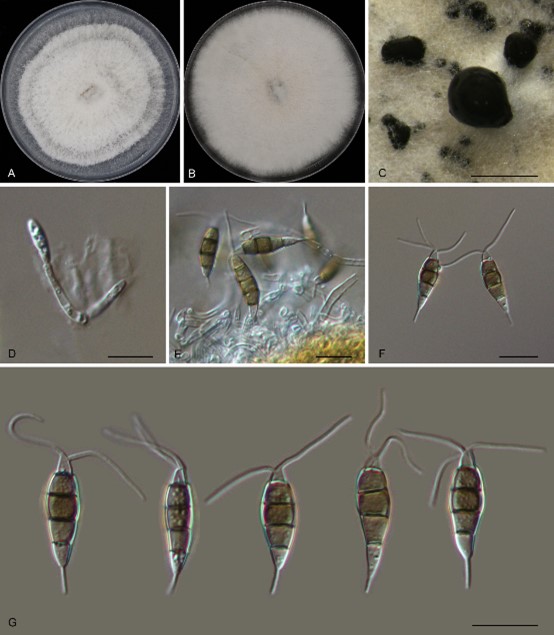Pestalotiopsis anhuiensis N. Jiang, in Jiang, Voglmayr, Xue, Piao & Li, Persoonia: 10.1128/spectrum.03272-22, 6 (2022)
Index Fungorum number: IF 843387; MycoBank number: MB 843387; Facesoffungi number: FoF 11689;
Etymology – named after the collection site of the type specimen, Anhui Province.
Pathogenic to host leaves. Asexual state: Conidiomata in culture sporodochial, aggregated or solitary, erumpent, pulvinate, black, 50–300 μm diam., exuding black conidial masses. Conidiophores indistinct, usually reduced to conidiogenous cells. Conidiogenous cells hyaline, smooth, cylindrical to spherical, annelidic, 3.5–13.5 × 2–3.5 μm, mean ± SD = 8.2 ± 2.6 × 3.1 ± 1.1 μm. Conidia fusoid, straight or slightly curved, 4-septate, smooth, slightly constricted at the septa, (18.5–)20.5–23.5(–25) × (6–)6.5–7.5(–8) μm, mean ± SD = 21.8 ± 1.4 × 7.1 ± 0.4 μm (n = 50), L/W = 2.7–3.8; basal cell obconic with a truncate base, thin-walled, hyaline or pale brown, (3.5–)4.5–5.5(–6) μm; median cells 3, trapezoid or subcylindrical, concolourous, pale brown to brown, thick-walled, the first median cell from base (4–)5–6 μm long, the second cell 4–5 μm long, the third cell (3.5–)4–5(–5.5) μm long, together (12–)13–15.5(–17) μm long; apical cell conic with an acute apex, thin-walled, hyaline, (2.5–)3–4(–4.5) μm long; basal appendage single, unbranched, tubular, centric, straight or slightly bent, (4–)4.5–6.5(–7) μm long, mean ± SD = 5.4 ± 0.9 μm; apical appendages 2–3, unbranched, tubular, centric, straight or bent, (7.5–)12.5–17.5(–20) μm long, mean ± SD = 14.9 ± 2.6 μm. Sexual morph unknown.
Culture characters – Colonies on malt extract agar (MEA) flat, spreading, with flocculent aerial mycelium and entire edge, white, reaching a 70-mm diameter after 10 days at 25°C, forming black conidiomata with black conidial masses; on potato dextrose agar (PDA), flat, spreading, with flocculent aerial mycelium forming concentric rings and entire edge, white, reaching a 70-mm diameter after 10 days at 25°C, forming black conidiomata with black conidial masses.
Material examined – China, Anhui Province, Hefei City, Shushan District, Dashushan Forest Park, on diseased leaves of Cyclobalanopsis glauca (Fagaceae), 2 November 2019, Dan-ran Bian (holotype CAF 800044 = JNH0040; ex-holotype culture CFCC 54791).
Distribution – China
Sequence data – ITS: ON007028 (ITS1/ITS4); tef1: ON005045 (EF1-728F/EF2); tub2: ON005056 (Bt2a/Bt2b)
Notes – Pestalotiopsis anhuiensis from Cyclobalanopsis glauca is phylogenetically close to Pestalotiopsis abietis, P. disseminata, and P. guangxiensis (Fig. 1). Morphologically, P. anhuiensis shares similar conidial sizes with P. abietis and P. disseminata (18.5 to 25 by 6 to 8 μm in P. anhuiensis versus 19.9 to 31.2 by 5.8 to 8 μm in P. abietis and 18 to 25 by 6.5 to 8 μm in P. disseminata) (21–23) and has narrower conidia than P. guangxiensis (6 to 8 μm versus 7.5 to 9.5 μm in P. guangxiensis) (Table 1). However, P. anhuiensis can be distinguished by sequence data (nucleotide differences from P. abietis: in the ITS, 1/506 [0.2%]; in tef1, 4/470 [0.85%]; in tub2, 1/442 (0.23%); nucleotide differences from P. disseminata: in the ITS, 3/506 [0.59%], 1 insertion; in tef1, 8/470 [1.7%]; in tub2, 1 or 2/406 [0.25 to 0.5%]; nucleotide differences from P. guangxiensis: in the ITS, 1/506 [0.2%], 1 insertion; in tef1, 12/470 [2.55%], 1-bp gap; in tub2, 2 or 3/442 [0.45 to 0.68%]).

Fig. 6. Morphology of Pestalotiopsis anhuiensis (CFCC 54791). A. Colony on PDA after 10 d at 25 °C; B. Colony on MEA after 10 d at 25 °C; C. Conidiomata formed on PDA; D, E. conidiogenous cells giving rise to conidia; F, G. conidia. — Scale bars: C = 300 μm; D–G = 10 μm.
